Downsizing to a Tiny Home: A 5 Step Guide
The tiny house movement has swept all throughout Australia. Researcher Heather Shearer of Griffith University describes “a marked increase in people who want their own tiny house.” According to her two-year study, people mostly cited economic reasons for downsizing, others mentioned “environmental sustainability and conscious consuming.”
Downsizing might feel overwhelming at first, but don’t fret, we’ll break it down for you!
How to Downsize to a Tiny Home
1. Do Your Research, Write Down Your Reasons
Every great thing starts out as a plan, including something as significantly life-changing as downsizing to a tiny relocatable home. Write down the reasons why you’re downsizing, especially your goals. Is your goal to get closer to financial freedom? To save money? To clear up space in your life for more important things? Keep an online, or physical “inspiration” board to keep your goals top of mind.
2. Take Inventory of Your Stuff

It’s so easy to lose track of all the things that we own. The only time people actually get close to actually taking inventory of the things that they own is when it’s time to change addresses. Keep in mind: downsizing to a tiny home means that taking inventory won’t be a one-off part of your life, it will be a default part of it.
There’s no need to sort your things into piles at this stage. It’s enough to make a list of everything that a room or a section of your house contains, and decide which ones are worth keeping and which ones need to be donated, given away, sold, or (responsibly) disposed of. Jot down possible end goals for more “difficult” items (i.e. items that you’re not sure whether you’ll keep or let go of). For example, for a lampshade given to you by a dear friend, you can write down “If there’s space, keep, if not, sell.” This is a huge task, but it will make things easier for you down the line.
3. Start Checking Out Tiny House Options
The next step in the process is to slowly take the planning process into the realm of reality. Visualize your plans: will your tiny home be stationary, or are you planning to move it around at some point? In that case, finding relocatable homes for sale may be the better option. How much time will you be spending inside your tiny house? This will help give you a general idea of what your tiny home requirements will be. Read up on regulations, permits, and building codes.
Join local tiny house communities online and learn from people’s real-life experiences.
If you’re thinking of hiring a company, keep in mind that a lot of tiny and relocatable home builders and construction companies actually offer free consultations to potential clients. Take advantage of these free sessions. It’s never too early to look for builders!
4. Take a Deep Breath and Start Letting Go

Of your things, that is. After taking inventory of the things and keeping in mind how big your future home will potentially be, you can finally start letting go of stuff. One of the organization methods that people swear by is the KonMari method, a technique created by the Japanese organizing consultant and author Marie Kondo. The technique is largely based on prioritizing which items “spark joy”, finding a place for them in your home, and quietly thanking all of the non-essential items for their service and completely letting them go.
A tip: start letting go of the things that you’re 100% you will be getting rid of. The feeling of success that you get from that will get you going!
5. Get into the Minimalist Headspace
As you go through the process of letting go of things, it’s important to ensure that you don’t slide back into the loop of mindless acquisition of things. Books, forums, and podcasts on minimalism are amazing allies to have in this journey!
6. Go Tiny!
Contrary to popular belief, you don’t need to move to a tiny portable house in order to live tiny. Save money by downsizing to an apartment or a granny flat that’s closer in size to your future tiny home. Once you’re ready to move to your relocatable home, there won’t be that much of a learning curve and adjustment required.
7. Why Switch to a Tiny House?
View this post on Instagram
Whatever your reasons might be for considering to downsize, let us congratulate you for even considering it. A lot of people are finding incredible meaning and joy in simplifying their lives and reducing the things that they own. “Living tiny” has allowed some people to shift focus towards the more priceless, genuine parts of life. According to tiny house dweller Chris Schapdick:
“A tiny house can teach you how little you really need to be content and happy in a world that pushes more things and larger dwellings as being desirable.”
The idea of living in tiny or portable modular homes might be daunting at first, but we hope these tips gave you a couple of valuable pointers to help you start.
Have you ever considered moving into a relocatable home? Share your thoughts in the comments section below.
If you think that a tiny home is the perfect home for you, send us a message now. Let’s explore your options!
Want to learn more? Check out this video!
One thought on “Downsizing to a Tiny Home: A 5 Step Guide”
Comments are closed.




Minimalist Lifestyle: Benefits of Having a Tiny Home - RooHome
[…] more. It is amazing how they use the space to its maximum without sacrificing the modern feature of living in a tiny home. More space means a more clear and calmer mind. The beauty of living a simple life with your small […]
September 11, 2021